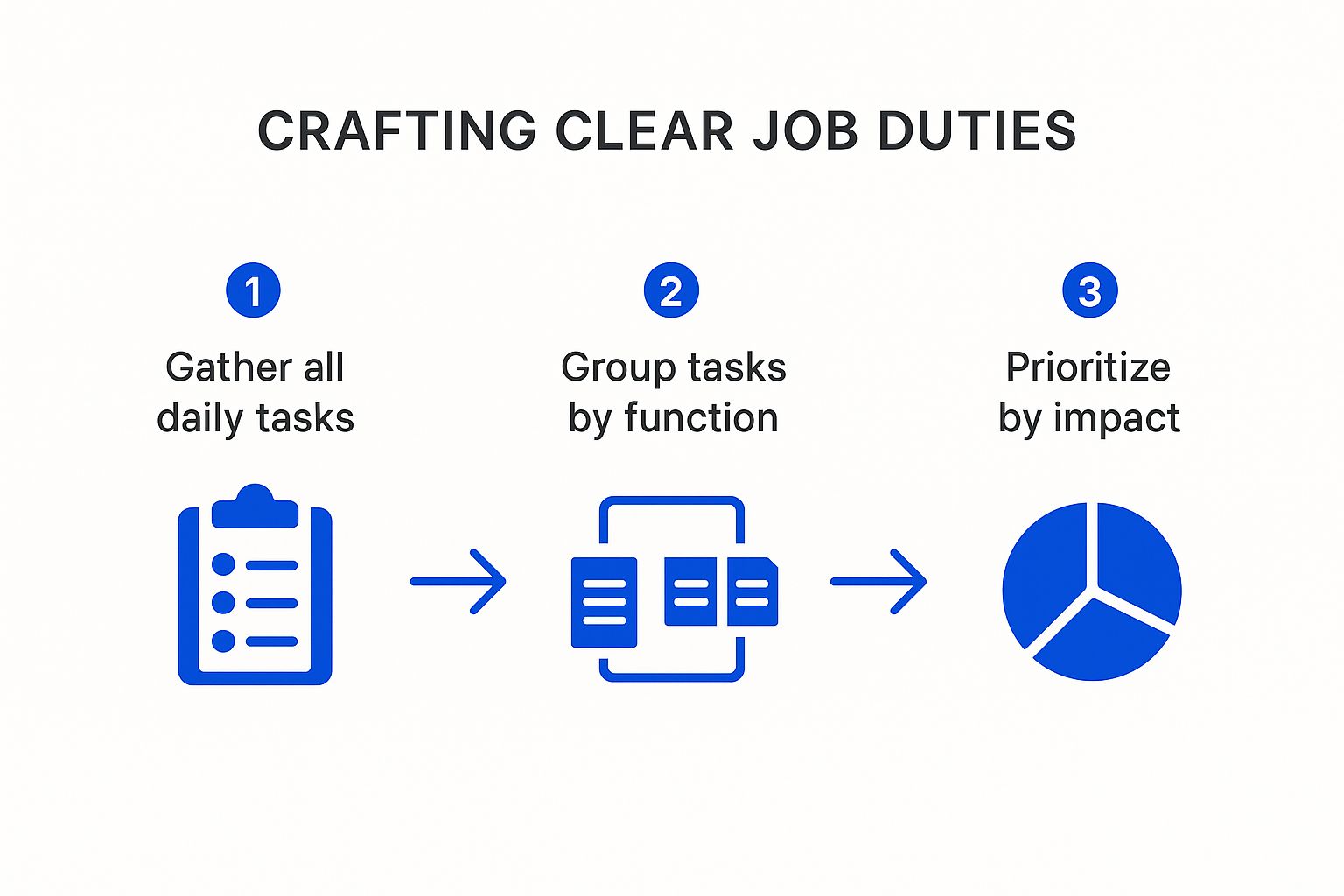Let's be honest, most job descriptions are a snooze-fest. They read more like a legal document than an exciting invitation to join a team. If you want to write job descriptions that actually pull in top talent, you need to think of them as your first, most important sales pitch.
Why So Many Job Descriptions Miss the Mark
Too often, hiring managers fall into the trap of treating the job description like a simple checklist. The result? A wall of vague corporate jargon, endless bullet points, and a tone so generic it could be for any company, anywhere. Candidates just scroll right past because there's nothing to grab their attention—nothing that shows them what makes your role and your company special.

Clarity is just as crucial as creativity here. When the responsibilities sound more like a list of contractual obligations than a description of daily impact, you lose people. This approach doesn't just bore candidates; it clogs up your hiring funnel with mismatched applications and sends the best people running.
It usually comes down to a few common mistakes:
- Relying on buzzwords that don't mean anything to people outside your company.
- Focusing on a laundry list of tasks instead of the key contributions the person will make.
- Forgetting to include the things that genuinely spark interest, like the salary range and perks.
A compelling job description is your secret weapon in the war for talent. It's your first handshake, your opening line, and your chance to make a brilliant first impression.
The Classic Pitfalls to Avoid
I see it all the time: HR teams grab an old template, do a quick find-and-replace, and post it. This one-size-fits-all approach completely misses the nuances of the role and the team. It also ignores the reality of the current job market. A CIPD report highlighted that 33% of UK employers are struggling with hard-to-fill vacancies, and a staggering 36% are facing a skills shortage. You can't afford to be generic. Read the full research about UK jobs and vacancies.
A simple fix is to group the essentials under clear, scannable headings. Instead of dumping every possible duty into a long list, focus on the three to five core responsibilities that will define success in the role.
- Prioritise what matters. What will this person actually be doing day-to-day?
- Use action-oriented language. Words like "drive," "build," and "grow" are far more engaging than "responsible for."
- Describe outcomes, not just activities. What is the goal of their work?
The Real-World Impact on Your Hiring
When you get the job description wrong, the consequences are very real. An uninspiring post means top performers are more likely to accept an offer from your competitor. It also means your HR team wastes countless hours sifting through irrelevant CVs.
The numbers don't lie. In 2024, companies reported spending 62% more time per hire when their job descriptions were vague. On top of that, a poor description damages your employer brand and can even lead to lower retention rates down the line.
Getting this right isn't just a "nice-to-have." A simple shift in your tone and clarity can genuinely cut your screening time in half and dramatically improve the quality of candidates you attract.
It's All About Shifting Your Mindset
Start thinking of a job description as a powerful employer branding tool. It's an opportunity to showcase your company culture and what makes you a great place to work. For more on this, check out our guide on what is employer branding.
When you write for people first and search engines second, every word counts. Clear, concise language saves everyone time and helps candidates make a quick, informed decision. More importantly, it positions your company as transparent and candidate-focused.
An engaging description also builds trust and excitement from the get-go. Candidates notice when you speak directly about the team culture, opportunities for growth, and the real challenges of the role. That kind of authenticity can boost your application rates by up to 25% and even encourage more referrals.
Ultimately, if your job description feels personal, purposeful, and human, it invites the right people to apply. It’s as simple as that.
Crafting a Job Description That Truly Connects
Alright, we’ve established why those dull, copy-pasted job descriptions just don’t work. Now, let's get into the nitty-gritty of building one that actually gets results. The mission here is to stop thinking of this as an admin task and start treating it like a piece of recruitment marketing. Every single part, from the job title to the benefits list, is an opportunity to sell the role to the right person.
A truly great job description does more than just list duties; it persuades. It tells a story about the role, the team, and what your company is all about. When you get it right, the best candidates will feel like you wrote it just for them.
Nailing the Job Title and Summary
First things first: the job title. This is your headline, and it has to be searchable and accurate. I've seen some creative ones over the years, like "Customer Happiness Ninja," which might sound fun inside the office, but I can promise you, nobody is typing that into a job search engine. They're looking for "Customer Support Manager." Stick to standard, industry-recognised titles.
Once you have their attention, the summary is your chance to hook them. This is where you sell the why of the job, not just the what. Don't lead with a dry, corporate-speak intro. Instead, paint a picture of the opportunity and who you're looking for.
Take this common example:
"We are seeking a motivated Marketing Manager to join our team. The successful candidate will be responsible for overseeing all marketing campaigns and ensuring they are executed effectively."
It’s fine, but it’s forgettable. Let's give it some life:
"Are you a creative and data-driven marketer who thrives on bringing brands to life? As our new Marketing Manager, you'll take the lead in shaping our narrative, driving impactful campaigns that connect with our audience and directly contribute to our growth. You'll join a collaborative team where your ideas will help define the future of our brand."
See the difference? We've gone from a passive statement to an active invitation that speaks directly to a candidate's ambition.
Defining Responsibilities with Purpose
The responsibilities section is where most job descriptions turn into an endless, mind-numbing laundry list. To avoid that trap, you need to focus on outcomes, not just tasks. Instead of listing every single little thing the person will do, group related duties into core functions and explain the goal behind them.
This simple infographic gives a great visual of how to think through this process, helping you clarify and organise job duties for maximum impact.

This workflow is all about moving from a jumbled list of tasks to a clear, prioritised set of responsibilities. It ensures that what’s most important about the role is front and centre.
Here are a few quick tips to put this into practice:
- Kick off with action verbs. Words like "develop," "manage," "analyse," and "lead" immediately create a sense of ownership and energy.
- Connect tasks to their impact. Don't just say "Create weekly reports." Instead, try something like, "Analyse performance data to provide weekly insights that guide our marketing strategy." Now the candidate understands the purpose of their work.
- Keep it focused. Aim for 5-7 core responsibilities. Any more than that, and it starts to look overwhelming. It can even signal that the role itself lacks a clear focus.
To give you a clearer picture, I've put together a table that breaks down the key parts of a stellar job description.
Key Components of an Effective Job Description
This structure ensures you cover all the crucial information in a way that’s both informative and genuinely engaging for potential applicants.
Listing Qualifications Without Discouraging Talent
This is a big one. The qualifications section is often where companies accidentally filter out fantastic candidates. Overly rigid requirements, like demanding "10+ years of experience," can scare off talented people who have the skills but followed a non-traditional career path.
The best approach I’ve found is to split your requirements into two buckets: the absolute must-haves and the nice-to-haves.
Be realistic about what someone genuinely needs to succeed from day one. Is a specific university degree truly essential, or would equivalent hands-on experience be just as valuable? Making that distinction clear instantly broadens your talent pool.
Let's look at the contrast:
The "After" column focuses on capability—what the person can do—rather than just checking a box for a specific credential. This invites a much more diverse and skilled group of people to apply.
By focusing on capabilities over credentials, you open the door to talented individuals who may have gained their expertise through hands-on experience rather than a traditional academic route. This is key to finding hidden gems in the job market.
The Power of Salary and Benefits Transparency
In today's job market, leaving out the salary range is a huge mistake. It’s that simple. All the data shows that job posts with pay information attract better-quality candidates and just make the whole recruitment process more efficient. A ZipRecruiter survey found that 75% of employers agree that pay transparency helps them attract better talent.
Being upfront about compensation shows you respect a candidate's time and builds trust from the very first click. And please, be specific. A vague phrase like "competitive salary" means nothing. Provide a realistic range.
Then, go beyond the standard list of benefits. Instead of just "Health Insurance," talk about the perks that truly reflect your company culture.
- Financial Wellness: Mention pension contributions, bonus schemes, or access to financial advice.
- Work-Life Balance: Talk about a generous holiday allowance, flexible working hours, or dedicated mental health days.
- Professional Growth: Highlight things like a personal training budget, mentorship programmes, or opportunities to attend conferences.
When you detail these benefits, you help candidates actually picture themselves thriving at your company. It makes your offer so much more compelling, especially when compared to a competitor who’s being secretive. This level of transparency isn't a perk anymore; it's a baseline expectation.
Writing for People First and Search Engines Second

It’s a classic dilemma: you write a brilliant job description, but what good is it if no one ever sees it? This is where you have to wear two hats. You’re writing for the candidate you want to hire, but you also need to play nice with the search engines that power job boards like LinkedIn and Indeed.
The trick is to find that sweet spot between persuasion and optimisation.
Remember, SEO gets you found, but genuine, human language gets you applications. A job post stuffed with keywords might climb the search rankings, but it won’t convince top talent to actually apply. The real goal is to weave those keywords into your text so they feel like a natural part of the story you’re telling.
Think of it this way: your ideal candidate isn't just searching for a job title. They're looking for a place where their work matters, where they can grow, and where they feel they belong. Your job description needs to speak to both the algorithm and the human behind the screen.
Finding the Right Keywords
So, how do you figure out which keywords to use? You don't need a fancy SEO subscription to get started. The best approach is to simply put yourself in the candidate’s shoes. What words would they type into a search bar?
Go beyond the obvious job title. Brainstorm specific skills, technologies, and industry phrases.
- Snoop on your competitors. Look at how other companies are advertising similar roles. What common phrases, skills, and qualifications pop up again and again?
- Use the job boards themselves. Start typing potential job titles or skills into the search bars on LinkedIn or Indeed. Pay attention to the auto-complete suggestions—they’re a goldmine of real-world search terms.
- Think in synonyms. A "Content Strategist" might also be searching for "Content Marketing Manager," "Digital Content Lead," or even "Brand Storyteller."
Once you have a solid list, pick the ones that most accurately reflect your role. This isn't about gaming the system; it’s about aligning your language with the language your target audience is already using.
Weaving SEO into Your Narrative
Now for the important bit: adding those keywords without sounding like a robot. The best places to focus your efforts are the core sections of your job description—the title, summary, and responsibilities. These carry the most weight with search algorithms.
For instance, say you’re hiring a "Project Manager" and you know from your research that "Agile methodologies" and "stakeholder management" are crucial search terms.
Instead of: "Responsible for project oversight."
Try: "You will lead key projects using Agile methodologies, ensuring clear communication and effective stakeholder management from kick-off to completion."
See the difference? The second version is far more specific and informative for the candidate, and it’s a beacon for search engines. The keywords feel natural because they are tied directly to the core functions of the job.
Speaking a Human Language
With the SEO fundamentals covered, it’s time to double down on the human element. This means one thing above all else: ditch the corporate jargon.
Empty buzzwords like "synergise," "liaise," or "leverage" are a huge turn-off. They’re vague, stuffy, and create an instant barrier between you and the candidate.
A job description should sound like it was written by a person, for a person. If you wouldn't say it out loud in a normal conversation, don’t write it down.
Swap out those tired old phrases for simpler, more direct alternatives that actually mean something.
This isn’t just about clarity; it’s about culture. This simple shift in language makes your company feel more grounded and approachable. Candidates get a genuine glimpse into how your team actually communicates. Ultimately, authentic language attracts authentic people. It’s a small change that makes a huge difference.
Designing for Scannability and Maximum Impact
Let's be honest, how do you read things online? You scan. Your eyes jump from headings to bold text to bullet points, hunting for the information you need. Job seekers are no different, and they're often doing this on a tiny phone screen while juggling a dozen other things. A massive wall of text is an instant turn-off.
Structuring your job description for a quick scan isn't just about aesthetics; it's a critical part of your recruitment strategy. A clean, organised layout helps a candidate decide—in seconds—if the role is right for them. That saves everyone a huge amount of time.
Embrace White Space and Short Paragraphs
If you do one thing, do this: keep your paragraphs short. I’m talking two or three sentences, max. Anything longer becomes a daunting block of text, especially on mobile.
This simple change forces you to be concise and creates valuable white space around the words. That bit of breathing room makes the whole page feel more approachable and guides the reader's eye downwards, encouraging them to keep going.
Use Bullet Points and Bold Text with Purpose
Bullet points are a godsend for job descriptions. They're perfect for listing responsibilities, qualifications, and benefits in a way that’s incredibly easy to digest. They break up the flow and let a candidate quickly run through a mental checklist.
Instead of a long, winding sentence, try framing your points like this:
- Lead the development of our quarterly content calendar, from initial idea to publication.
- Analyse campaign performance using Google Analytics to shape our future strategy.
- Collaborate with the sales team to create compelling case studies and sales materials.
See how the bold text makes the action verbs pop? Highlighting these key skills or critical requirements draws the eye straight to what matters most. Use this technique sparingly to emphasise things like essential software skills, key performance targets, or unique perks. It’s a simple trick that ensures even the fastest of skimmers get the main message.
Prioritise Clarity and Brevity
In a crowded job market, clarity always wins. Candidates are scrolling through dozens of ads, and a concise, direct approach stands out. In fact, research from Insight Global found that job descriptions under 300 words get 8.4% more responses than longer ones.
What's more, over half of UK job seekers say that the overall quality of the ad—including its formatting and grammar—directly impacts their decision to apply. The data is clear: trim the fat. Every single word needs to earn its place on the page.
Don't confuse length with substance. A punchy, scannable job description that respects a candidate's time will always outperform a long-winded one full of corporate jargon. The goal is to make a strong impact, fast.
Structure with Clear Subheadings
Think of subheadings as signposts. They guide candidates through the different parts of your job description, breaking it down into logical, easy-to-handle sections.
Use descriptive headings so someone can immediately jump to the part that interests them most.
A Simple, Effective Structure
This kind of clear structure helps candidates find what they need, fast. They can instantly see if they're a good fit and what's in it for them, which creates a positive experience from the very first click. Your job is to make it as easy as possible for the right person to look at your ad and think, "Yes, this is for me."
Defining Your Remote or Hybrid Work Environment
Let’s be honest: slapping a "remote" or "hybrid" label on a job description just doesn't cut it anymore. Top candidates have options, and they're looking for clarity, not ambiguity. If you're vague about what your work model actually means day-to-day, you’re setting yourself up for a world of mismatched expectations and wasted interview time.
You might even lose out on the perfect person simply because they couldn't figure out if their life fits your setup.

This is your first real chance to build trust. Go beyond the label and paint a clear picture of the work experience. By being upfront, you attract people whose needs genuinely align with what you’re offering, which is a win for everyone involved.
Spell Out the Specifics of Your Work Model
"Hybrid" can mean a thousand different things. Does it mean one day in the office or four? Fixed days or a free-for-all? Candidates need to know the logistics to decide if the role is a real possibility for them.
Your job description should tackle these questions head-on:
- Office Expectations: How often is the person expected in the office? Is it 2 days a week? 3 days a month? Are those days set in stone (e.g., every Tuesday and Thursday) or is there some flexibility?
- Location Requirements: Can the candidate work from anywhere in the UK, or do they need to be within a reasonable commute of London for quarterly team meetings? Be specific.
- Time Zone Alignment: Are there core hours, say 10 am to 4 pm GMT, when everyone needs to be online for collaboration? Or is the schedule completely asynchronous?
Answering these questions shows you respect a candidate’s time. It lets them self-qualify, so you only get applications from people who can genuinely meet the role's practical demands. If you're formalising this for your company, a structured guide can be incredibly helpful. You can get ideas from this comprehensive remote work policy template to make sure you've covered all your bases.
A well-defined work environment isn't just a logistical detail; it's a reflection of your company's culture and commitment to transparency. Getting this right helps candidates visualise their future with your team.
Showcasing Culture in a Remote Setting
One of the biggest anxieties for people looking at remote roles is the fear of feeling disconnected or isolated. Your job description is the perfect place to put those fears to rest by showing exactly how you build and maintain a strong, inclusive culture from a distance.
Think beyond the job itself. How do you make sure your remote team members feel like they truly belong?
Ways to Bring Remote Culture to Life
Details like these give candidates tangible proof that you've put real thought into creating a supportive remote-first environment. Mentioning perks like a home office stipend, a wellness allowance, or providing top-notch equipment only strengthens your case. When you articulate these things, you aren't just describing a job—you're inviting someone to join a community.
A Job Description Template and Checklist You Can Use Again and Again
Alright, we’ve covered a lot of theory. Now it’s time to put it all into practice. The real secret to consistently attracting top talent isn't just knowing what to write, but having a solid system in place to do it efficiently every single time.
This is where a good template comes in. Forget that dreaded blank page. Having a go-to structure saves you a ton of time and, just as importantly, ensures you maintain a professional, cohesive employer brand across all your open roles. It forces you to cover all the essential bases and makes it far easier for hiring managers and HR to collaborate without anything falling through the cracks.
Your Ultimate Job Description Checklist
Before you hit 'publish' on your next job post, give it a quick once-over with this checklist. Think of it as a final quality check to make sure you haven't missed any of the crucial elements we've talked about.
If you want to see how all these pieces fit together in a real-world example, take a look at our detailed accounts payable job description example.
- Clear, Searchable Title: Is the job title an industry-standard term that people are actually typing into search bars? Avoid internal jargon.
- Compelling Summary: Does your opening paragraph sell the opportunity and its impact? It should do more than just list tasks.
- Outcome-Focused Duties: Are the responsibilities framed around what the person will achieve? Stick to 5-7 clear, action-oriented bullet points.
- Inclusive Qualifications: Have you clearly separated the absolute "must-haves" from the "nice-to-haves"? This simple step can dramatically widen your talent pool.
- Full Transparency: Is the salary range stated upfront? Have you highlighted the benefits and any unique perks that make your company a great place to work?
- Scannable Format: Is it easy to read on a phone? Use short paragraphs, subheadings, and bold text to guide the reader's eye.
Treat this checklist less like a rigid set of rules and more like a pre-flight inspection. A quick review against these points can be the difference between a job description that gets scrolled past and one that lands your next great hire.
Frequently Asked Questions About Writing Job Descriptions
Even with the best templates and intentions, a few tricky questions always seem to pop up when you're trying to get a job description just right. Let's walk through some of the most common queries we hear from UK hiring managers, so you can finalise your listing with confidence.
What’s the Ideal Length for a Job Description?
There's no magic word count, but the sweet spot is concise yet comprehensive. From what we've seen, job descriptions that stay under 300 words consistently pull in more applications. Why? Because they're quick and easy for candidates to scan, especially on a mobile phone.
Think impact over exhaustive detail. You need to give someone enough information to understand the core of the role and decide if they're a potential fit. Save the nitty-gritty details for the interview. A punchy, well-organised description shows you respect a candidate's time, and that makes a brilliant first impression.
The best job descriptions are long enough to be meaningful but short enough to keep someone engaged. If a detail isn't essential for a candidate to decide whether to apply, it's probably best to leave it out.
Do I Really Have to Include the Salary Range?
Yes, absolutely. In today’s job market, salary transparency isn't just a nice-to-have; it's a baseline expectation for most candidates. Our data consistently shows that job ads with a clear salary range attract a higher volume of genuinely qualified people.
Think about it this way: omitting the salary wastes everyone's time. You end up interviewing people whose expectations are miles away from your budget, and it can even make your company look a bit secretive. Being upfront from the start builds immediate trust.
How Can I Make a Standard Job Title More Interesting?
For the main title, stick with standard, searchable terms. You want to show up when someone searches for "Marketing Manager," not "Marketing Guru." Where you can get creative is in a subtitle or the opening summary.
For example, a "Customer Service Representative" could be introduced as:
- Customer Advocate | Helping Our Clients Succeed
- Client Support Specialist | Tech Solutions Team
This tactic gives you the best of both worlds. You get the SEO benefit of a standard title while adding a splash of personality that gives candidates a better feel for what the role is really about.
What Are the Biggest Legal Pitfalls to Avoid?
This is a big one. In the UK, you have to be incredibly careful to avoid any language that could be seen as discriminatory under the Equality Act 2010. This means steering clear of any words that even hint at a preference for a certain age, gender, race, or physical ability.
A few key things to watch out for:
- Avoid phrases like "recent graduate" or "highly energetic," as they can be interpreted as age discrimination.
- Always use gender-neutral titles and pronouns. It’s "salesperson," not "salesman."
- Describe the essential functions of the job, not the physical attributes needed to perform them (unless it's a genuine and justifiable occupational requirement).
Before you post, give your description a final read-through with an eye for inclusivity. Make sure the language focuses purely on skills and experience, opening the door for every qualified applicant.

